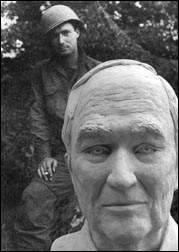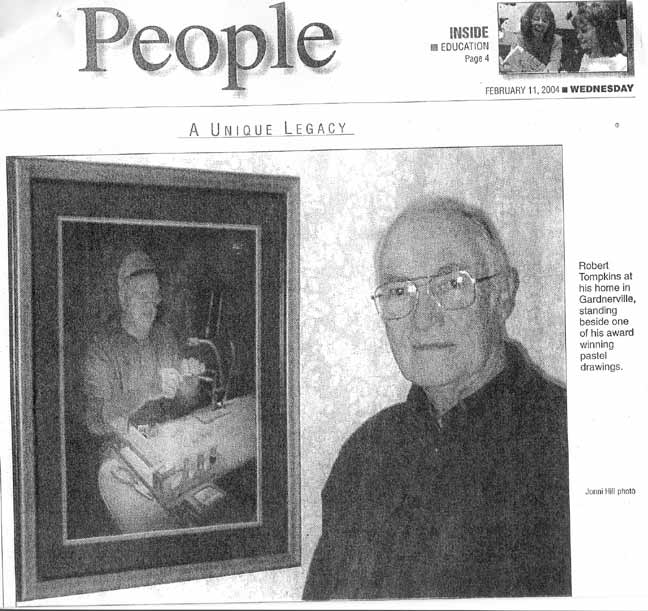|

Capturing history in art by Jonni
Hill, Special to the R-C February 11, 2004
| |
 |
| |
Robert Tompkins'
bust in front of a photo of him during World War II.
R-C graphic by Jonni Hill. |
Robert Tompkins
received a special honor recently. A Gardnerville resident these past 15 years,
Tompkins was one of 100 World War II veterans chosen to have his image
reproduced in clay sculpture for a special tribute to WWII veterans.
Kaija Keel, Claire Hanzakos and Jilda
Schwartz, Southern California artists, conceived this project more than two
years ago, when Keel was commissioned to do a bust of famed Southern California
photographer Warren King.
During WWII, King was a military photographer and
during the time he sat for the artist, he recounted stories of what he had done
in the war.
This planted the seed for the project which
sent Keel and her two associates (they worked together at Hanzakos' Studio) on
an historical odyssey.
Choosing appropriate subjects was hard at
times, said Keel, but the end result was a well-rounded tribute to what history
will record as "The Greatest Generation" of our time.
"When we started the project," Keel said,
"we didn't realize how big it would be.
"But as time and effort passed, we realized
we needed to represent the whole picture of the service men and women who
served, so we went to different places to locate special groups."
They also wanted a representative
cross-section of all the minorities, including women, and their contributions.
"We wanted to pay tribute to the idea of
service, not medals," Hanzakos said, adding the artists have been contacted by
the Veterans Administration inquiring about creating the images in bronze for an
outdoor memorial.
Even Hanzakos' 93 year old husband, Harry
Steinberg became a willing subject for the project.
Steinberg, a physician and an avid sculptor himself, was a major in the Army
Medical Corps during WWII. His medical unit was in place on the bluffs above
Omaha Beach just a day after the D-Day landing. His mobile hospital unit moved
forward with the troops throughout the European Theater.
Individual busts were created of the 100
veterans as they appear today. Then, they were displayed with photographs of the
men and women as they appeared during the war. A brief history of their
contribution to the war effort was also included.
And their contributions were as diverse as
the grains of sand on the Normandy Beach, which some of them had the good
fortune to survive.
Many familiar names appeared in the list of
100 including movie director Steven Spielberg's father, Arnold and uncle, Irvin
"Bud" Spielberg; movie director Delbert Mann; master furniture maker Samuel
Maloof; Academy of Motion Picture Arts and Sciences President Frank Pierson; and
Allan Adler, the "silversmith to the stars."
All were represented in a time of humble
beginnings.
Minorities including African American Tuskegee Airman Frank Jackson; George
Fujimoro, a Japanese American serving in Army Intelligence; Susan Ahn Cuddy, a
Korean American who taught the troops how to handle a machine gun; Maggie Gee, a
Chinese American who was one of several women pilots, are all noted in this
unusual display of human endeavor and honored for their contributions.
Which returns us to Tompkins, who is not
without his own story to tell.
Until 1996, when the information of a top secret unit to which Tompkins was
assigned was declassified, Tompkins was only allowed to say he was a camoufler
in the Army Corps of Engineers.
He can now share that he was part of the
23rd Headquarters Special Troops, known otherwise as the Ghost Army.
Until then, his contributions went far
beyond what he was allowed to talk about.
The Ghost Army was a top secret American Army unit comprised of actors, writers,
artists, sound experts and set designers whose sole purpose was to confuse,
mislead, and deceive the German army.
The U.S. Army picked the brightest and best
from all facets of the arts and entertainment world.
The directive handed down from the secretary of war stated, in part
"Organization of the 23rd Headquarters Special Detachment ... consigned to the
Second Army, would have an authorized strength of 13 officers, one warrant
officer and 54 enlisted men."
This was the official nucleus designed to
start a 1,300-man elite unit, although its actual strength was 1,100. The demand
for secrecy for this unit was so intense, new recruits were acquired without
requisition through normal Army channels.
Tompkins was attending Pratt Institute in
Brooklyn, N.Y studying advertisement design when the call of war was sounded in
1942 following the attack on Pearl Harbor.
Like many of his fellow Americans, Tompkins
enlisted in the Army. It was in basic training at Ft. Meade, Maryland in 1943,
that he met Pvt. Bill Blass, who would achieve greatness as a fashion designer.
Tompkins and Blass were both assigned to
the Ghost Army due to their artistic talents.
The time and experiences they shared during their war years cemented a
relationship which endured until Blass' death on June 12, 2002 just 10 days shy
of his 80th birthday.
Tompkins, knowing his life long friend was
not going to live much longer, traveled to Blass' Connecticut estate.
While there, Tompkins took photographs of
Blass, who was conducting business on the phone with his constant companion, a
yellow lab named Barnaby, by his side.
Returning home, Tompkins did a special
drawing of his war time buddy -- a simple soft pastel sketch in sepia tones --
delivered to his friend on Christmas Eve. Its simplicity reveals the emotion of
a friendship they nurtured for almost 60 years. A copy of the original hangs in
the Tompkins' home as a constant of the memories.
Tompkins married his high school
sweetheart, Bunny Hart on April 13, 1943, while he was in basic training.
For her part, Bunny gave up a promising
modeling career with the John Powers Modeling Agency be a military wife, and to
follow "the love of her life."
On May 2, 1944, Tompkins found himself the
Henry Gibbons, a troop transport ship, the Henry Gibbons, bound for England.
What made his departure more
heart-wrenching, he said, was that Bunny and he were expecting their first
child.
Due to the top secret nature of their jobs,
most of the men of the 23rd thought they were bound for the Pacific and not
Great Britain which was soon to be their staging area.
Not even their families knew their final
destination although some of the men were able, through subterfuge, to give
their loved ones a rough idea of their location.
During this time, Tompkins kept a secret
diary which, if discovered, would have been a shooting offense.
Although seemingly benign, in the event of
Tompkins capture, the diary would have provided enough information for the enemy
to discover what the 23rd was up to.
Today, his diary is an historical account
of a well kept secret and has been published in a fascinating account titled
"Ghost Army of World War II" by Jack Kneece.
Even though his year in Europe was not with
a combat unit in the front lines, it was not without extreme danger.
The 23rd supplied the decoys that fooled the Germans into thinking U.S. troop
strength was twice what it was. This was achieved using rubber dummies of all
sorts of equipment, such as tanks and large gun emplacements which were supplied
by rubber companies including B.F. Goodrich and Firestone.
Elaborate sound effects, special lighting,
camouflage, even painted shadows on the ground were all designed to mask the
movement of fighting troops from one area to the next and give the Germans a
sense of mighty American strength.
Truth was, America had entered WWII
undermanned and ill equipped. If it hadn't been for the deceptive tactics of the
23rd, the seasoned war machine of the Third Reich would have inflicted a lot
more casualties than they did.
All the deceptive work was not with out typical
Army SNAFU's. In an account from Tompkins, it was not unusual to work late at
night setting up a battalion of dummy equipment only to find by morning that
atmospheric weather changes had caused the inflations to leak, leaving sagging
gun turrets and tanks rippling in the breeze.
Apparently none of these problems were ever
detected by the enemy.
It was hard for Tompkins to be away from his wife during her pregnancy. His
worrying was compounded by the lack of communication due to his unit's constant
movement.
According to a diary entry, this weighed
more heavily on his mind than all the danger he faced daily.
Robert Junior was born Dec. 18. Bunny tried desperately to get the news to
Tompkins by way of a cablegram which proved to be undeliverable. Undaunted, she
placed a notice in the military magazine, Stars and Stripes, hoping the news
would reach him.
One happy, relieved and elated new father
received the news on Dec. 29, his diary recounts.
Immediately after his return from the war, Tompkins began what became a
successful career. He worked as art director with Young & Rubicam Advertising
producing ads for national accounts in New York and Los Angeles. After 25 years
in the ad business, he formed his own graphic design firm in Los Angeles and
worked as a design consultant to such clients as Union Oil Company of
California, The Squirt Co. and various major banks in Southern California. In
1982 he joined Union Oil (now known publicly as UNOCAL 76) as manager of graphic
art production. He continued as a design consultant for the firm creating
promotional pins for the Los Angeles Dodgers and the Oakland A's sponsored by
UNOCAL.
When he finally decided to retire, the
couple looked at many locations but, because they had owned a cabin in the Twin
Lakes area near Bridgeport, and they had many friends in the area, their final
decision was Gardnerville.
Tompkins has time now to enjoy the
leisurely pursuits of the fine art world. His work, mostly in pastel, are award
winners.
The Tompkins had three sons. The oldest, Robert "Butch" Jr. works for the
Mineral County Sheriff's Dept in Hawthorne. Their middle son, Lawrence "Spike"
Tompkins is executive vice president for Independent Television Network
Incorporated in Chicago. Their youngest son Mark, is an oil painter and teaches
the craft at Austin Arts in Carson City.
The initial exhibit of the 100 sculptures
of the veterans at Jose Drudis-Biada Art Gallery at Mount St. Mary's College,
has closed.
The artists are now looking for venues to
place the display on tour. Any interested galleries are welcomed to contact the
Art Options Foundation at (310) 472-3448.
| |
 |
| |
Comments from the Webmaster
2-20-2004
It was exciting to read this article,
and learn more about Bob's life. It was doubly exciting for me, as I
worked with Maggie Gee for about 40 years at the Lawrence Livermore
Laboratory! She didn't talk much about her WWII experience, like many
veterans. Maggie was a very bright, quietly competent and
friendly lady. Life is full of happy coincidences!
The "Rad Lab" is also where I met Lynn
Kelly, and I'm sure she knows Maggie as well.
I've been away from Livermore for 18 years, and haven't kept up with some of
my friends.
Here are two books about the Ghost
Soldiers:
"Secret Soldiers" The Story of World War II's Heroic Army of Deception - by
Philip Gerard
"Ghost Army of World War II" - by Jack Kneece
Gordon Pefley |
[Top of Page]
|
